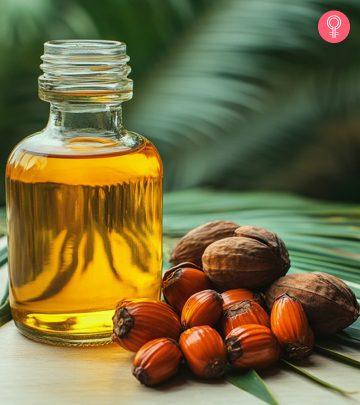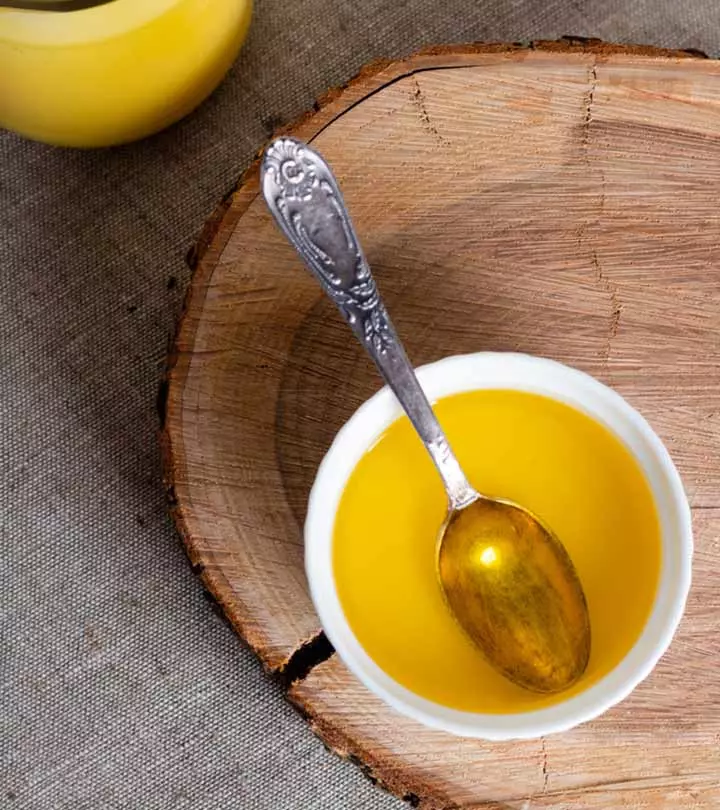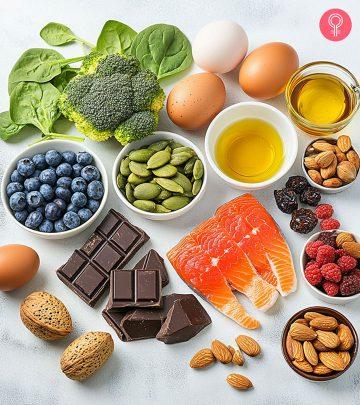5 Benefits Of Buckwheat, Nutrition Facts, And Side Effects
This whole grain has made a comeback as a superfood for its multiple health benefits.

Image: Shutterstock
Buckwheat benefits your health in many ways. It is gaining popularity as a gluten-free and plant-based food. Pseudocereal buckwheat is also referred to as kasha. 100 gms of this pseudocereal (a seed with similar properties as cereals) offers 10 grams of fiber, 231 milligrams of magnesium, 18 milligrams of calcium, and 13 grams of protein. These beneficial nutrients in buckwheat play a vital role in cutting down the risk of heart disease and cancer and managing diabetes.

Adding buckwheat to your diet is the best way to reap all the benefits it offers. A wide range of delicacies, such as pancakes, porridge, soba noodles, crackers, cookies, meals, salads, risotto, and crepes can also be made with buckwheat. Learn more about the buckwheat benefits and how to add it to your diet in this article. Keep reading!
 Know Your Ingredient: Buckwheat
Know Your Ingredient: BuckwheatWhat Is It?
A pseudocereal belonging to the Polygonaceae family.
What Are Its Benefits?
It may lower cholesterol, triglycerides, and blood glucose levels and boost heart health.
Who Can Consume It?
Anyone can have it except people with celiac disease or gluten sensitivity. People allergic to rice should also avoid it.
How Often?
It can be safely consumed every day in moderation.
Caution
Some individuals might be allergic or sensitive to it and can experience asthma, nausea, cramps, hives, skin rashes, or swelling.
In This Article
What Is Buckwheat?
Buckwheat is often mistaken to be a type of wheat when, in fact, it is a seed from a flowering plant of the same name. It dates back to nearly 6,000 years and is said to have originated somewhere in Southeast Asia before spreading to other parts of Asia and Europe. It finally made its way to parts of Northern America some time around the 18th century. It is a tough crop known to withstand and adapt to diverse climates. It has a short growth cycle, which makes it a sought-after ingredient during brutal seasons or times of food scarcity. Buckwheat has experienced a culinary resurgence in modern times, especially because of its gluten-free, plant-based, and sustainable status.
Keep reading to learn what else makes it a popular food choice.
Key Takeaways
- A nutritious whole grain that is high in vitamins and minerals is buckwheat.
- Given that it has a low glycemic index, it might be a useful meal option for people with diabetes or metabolic problems.
- The presence of protein and fiber may reduce the risk of heart disease and has anti-cancer qualities.
- As it contains several allergens, buckwheat may cause allergies that manifest as symptoms like asthma and skin rashes.
Buckwheat Nutrition Facts*
Buckwheat is energy-dense and is high in various vitamins and minerals. A cup of buckwheat (170 grams) contains 583 calories and 122 grams of carbohydrates. It also contains the following nutrients*:
- 23 grams of protein
- 15 grams of fiber
- 30 milligrams of calcium
- 4 milligrams of iron
- 393 milligrams of magnesium
- 590 milligrams of phosphorus
- 782 milligrams of potassium
- 51 micrograms of folate
*Values sourced from USDA, Buckwheat
Buckwheat contains all the amino acids and can be considered a complete protein.
This pseudocereal is also loaded with phytochemicals.
Studies reveal that whole buckwheat contains 2-5 times more phenolic compounds than oats or barley (1). While barley (jau) benefits include its own rich nutrient profile, buckwheat stands out for its high antioxidant activity.
Moreover, buckwheat bran and hulls have 2-7 times higher antioxidant activity than barley, oats, and triticale (1).
Buckwheat contains more rutin when compared to other grain crops. Quercetin, orientin, kaempferol-3-rutinoside, vitexin, isovitexin, and isoorientin have been identified in buckwheat hulls as well (1).
Buckwheat seeds also contain fagopyrins and fagopyritols. Fagopyrins are photo-sensitivei The property characterized by a change in the chemical composition of a particular substance when exposed to light. substances present in very low quantities in buckwheat. Fagopyritols are carbohydrate compounds accumulated in the embryos of these seeds (1).
Here’s the interesting part.
Most cereals and pseudocerealsi A class of plants that produces starchy seeds or fruits that can be consumed the same way as cereals. contain a considerable amount of anti-nutrients. Anti-nutrients interact with nutrients to prevent their proper absorption and trigger undesirable effects in your body.
But buckwheat has no trace of phytic acid, a common anti-nutrient. Hence, you can have these seeds without worrying about a cross-reaction or a loss of nutrients.
Adding buckwheat to your daily meal can offer certain health benefits. In the following section, we will look at these benefits and what research tells us about them.
 Trivia
TriviaWhat Are The Health Benefits Of Buckwheat?

The phytonutrients in buckwheat help in the treatment of diabetes, heart disease, and cancer. Regular consumption of these groats may also relieve constipation.
1. May Improve Insulin Sensitivity And Manage Diabetes
Animal studies show that buckwheat can lower blood glucose levels.
Buckwheat contains rutin, quercetin, d-chiro-inositol, and other similar biochemicals that may have a positive impact on the glucose levels in your body. In mice studies, ethanol extracts of buckwheat were found to treat insulin resistance (2).
In rat studies, buckwheat concentrate could lower serum glucose levels. Therefore, buckwheat may be useful in diabetes treatment (3).
Tartary buckwheat (Fagopyrum tataricum) has the highest quercetin and rutin content among all the buckwheat species. As per mice studies, its alcohol extract can increase the levels of antioxidant enzymes in the liver (2).
Including buckwheat in your diet could be a safe way of regulating diabetes and insulin sensitivity.
2. May Mitigate Cardiovascular Disease (CVD) Risk
Buckwheat may lower cholesterol levels, which may otherwise lead to cardiovascular disease.
The rutin in buckwheat is a well-studied cardioprotective flavonoid. Along with quercetin, protein, and fiber, this flavonoid lowers the risk of heart diseases. Despite having low digestibility, buckwheat may lower risk factors for cardiovascular disease (4).
Buckwheat may help lower blood glucose levels and levels of total cholesterol and triglyceridesi Most common fat type in the body, high levels of which can raise the risk of a heart attack or stroke. . Higher levels of these can elevate CVD risk (4).
However, whether the intake of buckwheat can have a similar impact on other CVD risk factors like body weight and LDL cholesterol is unclear (4).
Buckwheat flavonoids can interfere in various pathways that may lead to cardiac discomfort. In rat studies, buckwheat rutin was found to inhibit the abnormal enlargement of the heart muscle (a condition called cardiomyocyte hypertrophy) (5).
3. May Possess Anticancer Properties

The protein and amino acids in buckwheat may aid cancer prevention.
Buckwheat protein is rich in amino acids like lysine and arginine. In a study conducted in China, buckwheat proteins – in combination with polyphenols – induced cell death (apoptosis) in several mouse cell lines. They could counter the proliferation of cancer cells in the colons of rats (6).
A novel protein, TBWSP31, isolated from tartary buckwheat extracts, might exhibit antiproliferative propertiesi Tending to inhibit cell growth, especially the growth and spreading of cancerous cells into the surrounding tissue. against human breast cancer cell lines. The cells showed physical changes that are the typical characteristics of dying cancer cells (6).
Buckwheat hull was also reported to have anticancer effects in mice studies. Extracts of buckwheat hull showed relatively high cancer cell growth-inhibition rates. It is suggested that the buckwheat hull may possess anticancer activity against a variety of cancer cell lines (7).
4. May Relieve Constipation And IBD
Buckwheat proteins also exhibit laxative effects. In rat studies, buckwheat protein extract was found to be a useful agent for the treatment of undesirable constipation (8).
Buckwheat is a potent anti-inflammatory agent. Having it fermented or unfermented may tone down intestinal inflammation. However, we need more human trials and animal studies to further determine these effects (9).
Some anecdotal evidence suggests that buckwheat may cause gas in some individuals. If you experience any symptoms, discontinue use and consult your doctor.
5. May Help Treat Polycystic Ovarian Syndrome (PCOS)

Buckwheat may offer some relief to those with PCOS.
Buckwheat contains a compound called D-chiro-inositol, which is an insulin mediator. D-chiro-inositol is found to be deficient in people with polycystic ovary syndrome (PCOS) (1).
Researchers are trying to develop natural and synthetic variants of D-chiro-inositol to help manage PCOS. However, supplying this carbohydrate through diet showed positive effects as well. Buckwheat seed bran becomes the ideal choice in such cases (1).
The fragments of the outer leaves adhere to the bran during milling. Therefore, the bran fraction from buckwheat seed can be used to isolate the free D-chiro-inositol. It can be used for the large-scale production of nutraceuticalsi Medical or nutritional products that can be used as a medication apart from offering nutritional benefits. and pharmaceuticals to cater to the people with such a deficit (1).
 Did You Know?
Did You Know?In the following section, we have added a couple of quick recipes that can help you include buckwheat in your diet.
How And What To Cook With Buckwheat
You can substitute rice with this basic buckwheat groat preparation. It has more protein and a higher content of lysine and arginine, two essential amino acids.
A food blogger shared their experience of experimenting with buckwheat, “I toasted them in a pan on the stove over low-med heat…smelled so good – like fresh-baked bread!! And they added the most wonderful crunch to the salad (i).” Continuing the culinary journey, they cooked buckwheat just like rice, and noted, “The texture! Even cooked like rice, I still really love the texture of buckwheat!”
1. Simple Buckwheat Meal
What You Need
- Buckwheat groats: 1 cup, toasted (If you don’t find pre-toasted groats, you can toast them in a dry skillet over medium heat for about 4-5 minutes or until they turn golden-brown.)
- Drinking water: 1¾ cups
- Unsalted butter: 1-2 tablespoons (or to taste)
- Sea salt: ½ teaspoon (or to taste)
- Saucepan: medium-small size
Let’s Make It!
- Rinse the buckwheat and drain out the water thoroughly.
- Add buckwheat groats, water, butter, and salt to a medium-sized saucepan.
- Bring the contents to a simmer.
- Cover the pan with a tight-fitting lid and reduce the heat.
- Cook on low heat for 18-20 minutes.
- Stir in an additional tablespoon of butter if needed.
- Eat it with stew, stir-fried veggies, or your favorite curry!
You can also make something more flavorful with this pseudocereal. In fact, there are many gluten-free dishes that can be made with buckwheat. Here’s a quick and simple recipe. Try it out!
2. Gluten-Free Quick Crepes With Buckwheat

What You Need
- Buckwheat groats: ⅔ cups, raw
- Water: to cover
- Eggs: 1
- Brown sugar: 2 tablespoons
- Cinnamon: 1/4 teaspoon, ground
- Salt: 1/4 teaspoon
- Colander: small-medium sized
- Skillet
- Cooking oil
Let’s Make It!
- Add the buckwheat groats and about 1½ cups of water to a medium-sized colander.
- Soak for about 4 hours or overnight. Drain and rinse the groats 1-2 times during this period.
- After soaking, rinse and drain the groats one final time.
- Transfer the drained groats to a blender.
- Add the egg, brown sugar, cinnamon, salt, and half a cup of water to the blender.
- Blend into a smooth batter. Add water to get the desired consistency. Blend until you get a smooth, runny, and spreadable batter.
- Lightly grease a skillet and place over medium heat.
- Pour about ⅓ cup of batter into the skillet. Lift and tilt the skillet to coat the batter evenly. Return to heat.
- Cook for about 2 minutes.
- Flip the crepe gently and cook the other side until the crepe is firm in the middle. (Cook longer for a crispy crepe).
- Serve hot/warm with dips and berries of your choice or go classic with some honey or maple syrup.
Buckwheat oats taste very similar to the classic flour-based crepes you make.
People with celiac disease and gluten intolerance don’t need to miss out on some delicious crepes, thanks to buckwheat! You can also eat buckwheat raw; ensure you soak them well and rinse and strain before doing so. This will help in their digestion.
 Quick Tip
Quick TipHowever, you need to keep a watch on the amount of buckwheat you can eat in a day.
How Much Buckwheat Is Safe To Eat?
According to the FDA, in a 2,000 calorie-diet, the daily intake of fiber should be about 28 g (10). A cup of buckwheat (100 grams) contains about 10.4 grams of fiber (11). You may have the same on a regular basis. Since you also get fiber from other sources, this should not be a problem.
Your goal should be to get 100% of the daily value for dietary fiber on most days.
If you are showing symptoms of buckwheat allergy, or you don’t like how these seeds taste, you can choose other gluten-free grains to meet the fiber requirement.
Brown/black/red rice, oatmeal, quinoa, rolled oats, rye, and barley are some options that you can consider.
Not all may be able to consume buckwheat. It may cause adverse effects on certain people.
Side Effects Of Eating Buckwheat

Though it is gluten- and phytic acid-free, buckwheat seeds may have other anti-nutrients that trigger hypersensitivityi An exaggerated response by the immune system to particular substances or conditions, usually observed in allergies. .
One of the most reported and studied side effects is buckwheat allergy. Its symptoms include (12):
- Asthma
- Allergic rhinitis (sneezing, wheezing, runny nose)
- Gastrointestinal disturbancei Disorders related to the GI tract (which extends from the mouth to the anus) such as nausea/vomiting, food poisoning, and diarrhea. (nausea, cramps, etc.)
- Hives or skin rashes
- Swelling (face and skin)
If left untreated, it can turn fatal.
This happens because buckwheat contains several allergens. These digestion-resistanti The property characterized by the resistance of certain proteins to break down into amino acids in the intestine. proteins elicit an allergic reaction in your body. These allergens can cross-react with other plant allergens that are most commonly found in rice, poppy seeds, latex, cashew, and sesame (1), (12).
Hence, beware of what you eat buckwheat with. Eating these foods together might trigger the adverse effects listed above.
Research is still underway in this aspect. The exact allergen(s) structure and function of buckwheat have not been established yet.
Additionally, buckwheat proteins have low digestibility. This could be because the polyphenols in buckwheat interact with these proteins and make it harder for your colon to digest them (13).
Having probiotics may solve this problem.
If you notice any allergic reactions or adverse side effects after consuming buckwheat, it is important to seek medical advice promptly. A healthcare professional can help you get a proper diagnosis and appropriate treatment.
Remember, paying attention to your body’s response to new foods is always a good idea to ensure optimal health and well-being.
Infographic: Benefits Of Buckwheat For Your Health
Once you have read up on all the benefits of this superfood, it is a no brainer to add buckwheat to your diet. But when someone asks you why you eat it, its benefits may slip your mind. We have compiled a list of the top health advantages of this gluten-free food in the infographic below. Check it out now!
Some thing wrong with infographic shortcode. please verify shortcode syntaxBuckwheat is a gluten-free pseudocereal packed with the goodness of protein, fiber, essential vitamins, and minerals like magnesium, phosphorus, and calcium. It is not only suitable for people with gluten intolerance but also helps lower the risks of diabetes, heart disease, and certain cancers. Loaded with phytochemicals, buckwheat has more phenolic compounds and other antioxidants than oats or barley. To top it all, buckwheat is free of any anti-nutrients as well. Soups, salads, risotto, waffles, muffins, bread, pasta and noodles are some of the common ways to add buckwheat to your diet. It is a great option for vegetarians and vegans as well and is relished across countries, such as Japan, Europe, America, and Russia. In fact, Russia is one of the top farming countries that supports buckwheat agriculture. However, if buckwheat is not something for you then you can also indulge in other alternative options, such as oat or quinoa.
Frequently Asked Questions
How does buckwheat compare to quinoa?
While both buckwheat and quinoa are gluten-free and offer a variety of health benefits, they have distinct nutrient profiles. Buckwheat, for instance, is a rich source of protein and fiber, with a cup (170 grams) providing 23 grams of protein and 15 grams of fiber. In contrast, quinoa is a complete protein source, containing all nine essential amino acids. A cup (185 grams) of cooked quinoa provides 8 grams of protein and 5 grams of fiber. (14).
Is buckwheat keto-friendly?
No. Buckwheat is relatively high in carbs. 100 grams of buckwheat contains over 70 grams of carbs (11). Hence, it cannot be included in a keto diet.
Is buckwheat paleo-friendly?
Buckwheat is a grain, and since the paleo-diet does not contain grains, it is not paleo-friendly.
Is buckwheat good for muscle building?
Though there is no specific research regarding this, adding buckwheat to your meal can promote overall health and muscle growth (as it is nutritionally rich).
Does buckwheat make you sleepy?
Some sources suggest that buckwheat may trigger the production of melatonini A hormone released by the brain in response to darkness that improves sleep and controls the immune system and the circadian rhythms. , the sleep hormone. However, there are no reliable sources available.
How long does buckwheat take to cook?
A simple buckwheat meal takes about 20 minutes to cook.
Is buckwheat good for belly fat?
Research suggests that the high nutrient and fiber content of buckwheat can help with weight loss and reduced cholesterol levels, all of which can lead to reduced belly fat (15).
Does buckwheat have B12?
A: Buckwheat doesn’t contain vitamin B. However, buckwheat dough fermented with Propionibacterium freudenreichii can develop a high content of vitamin B12 (16).
Is buckwheat good for your liver?
Yes. An animal study found buckwheat sprouts could help lower the risk of fatty liver disease (17).
Is buckwheat good for your brain?
Yes, buckwheat may help maintain cognitive functioning and protect against age-related cognitive decline (18).
Does buckwheat cause bloating?
Buckwheat is comparatively more difficult to digest than wheat and legumes and may cause digestive issues (19). However, there is a lack of evidence regarding how commonly bloating occurs as a side effect of buckwheat consumption.
Illustration: Benefits Of Buckwheat, Nutrition Facts, And Side Effects

Image: Stable Diffusion/StyleCraze Design Team
References
Articles on StyleCraze are backed by verified information from peer-reviewed and academic research papers, reputed organizations, research institutions, and medical associations to ensure accuracy and relevance. Read our editorial policy to learn more.
- Phytochemicals and biofunctional properties of buckwheat: a review, Journal of Agricultural Science, Academia.
https://www.academia.edu/7121771/Phytochemicals_and_biofunctional_properties_of_buckwheat_a_review - Fagopyrum tataricum (Buckwheat) Improved High-Glucose-Induced Insulin Resistance in Mouse Hepatocytes and Diabetes in Fructose-Rich Diet-Induced Mice, Experimental Diabetes Research, US National Library of Medicine, National Institutes of Health.
https://www.ncbi.nlm.nih.gov/pmc/articles/PMC3324901/ - Buckwheat concentrate reduces serum glucose in streptozotocin-diabetic rats, Journal of Agricultural and Food Chemistry, US National Library of Medicine, National Institutes of Health.
https://pubmed.ncbi.nlm.nih.gov/14640572/ - Buckwheat and CVD Risk Markers: A Systematic Review and Meta-Analysis, Nutrients, US National Library of Medicine, National Institutes of Health.
https://www.ncbi.nlm.nih.gov/pmc/articles/PMC5986499/ - Buckwheat Rutin Inhibits AngII-induced Cardiomyocyte Hypertrophy via Blockade of CaN-dependent Signal Pathway, Iranian Journal of Pharmaceutical Research, US National Library of Medicine, National Institutes of Health.
https://www.ncbi.nlm.nih.gov/pmc/articles/PMC4232801/ - Anti-Tumor Activity of a Novel Protein Obtained from Tartary Buckwheat, International Journal of Molecular Sciences, US National Library of Medicine, National Institutes of Health.
https://www.ncbi.nlm.nih.gov/pmc/articles/PMC3100852/ - Cytotoxic effect of buckwheat (Fagopyrum esculentum Moench) hull against cancer cells, Journal of Medical Food, US National Library of Medicine, National Institutes of Health.
https://pubmed.ncbi.nlm.nih.gov/17651057/ - Buckwheat Protein Extract Ameliorates Atropine-Induced
Constipation in Rats, Current Advances in Buckwheat Research.
https://citeseerx.ist.psu.edu/viewdoc/download?doi=10.1.1.456.619&rep=rep1&type=pdf - Buckwheat and buckwheat enriched products exert an anti-inflammatory effect on myofibroblasts of colon CCD-18Co, Food & Function.
https://www.ncbi.nlm.nih.gov/pmc/articles/PMC6597957/ - Interactive Nutrition Facts Label – Dietary Fiber, U.S. Food & Drug Administration.
https://www.accessdata.fda.gov/scripts/interactivenutritionfactslabel/assets/InteractiveNFL_DietaryFiber_October2021.pdf - Buckwheat U.S. Department of Agriculture FoodData Central.
https://fdc.nal.usda.gov/fdc-app.html#/food-details/170286/nutrients - Buckwheat allergy: a potential problem in 21st century Britain BMJ Case Reports US National Library of Medicine National Institutes of Health.
https://www.ncbi.nlm.nih.gov/pmc/articles/PMC3214221/ - Protein-polyphenol interactions and in vivo digestibility of buckwheat groat proteins European Journal of Physiology US National Library of Medicine National Institutes of Health.
https://pubmed.ncbi.nlm.nih.gov/11005640/ - Quinoa cooked
https://fdc.nal.usda.gov/food-details/168917/nutrients - Effects of Tartary Buckwheat Protein on Gut Microbiome and Plasma Metabolite in Rats with High-Fat Diet, Foods, US National Library of Medicine, National Institutes of Health.
https://www.ncbi.nlm.nih.gov/pmc/articles/PMC8535877/ - Bioaccessibility of vitamin B12 synthesized by Propionibacterium freudenreichii and from products made with fermented wheat bran extract, Current Research in Food Science, ScienceDirect
https://www.sciencedirect.com/science/article/pii/S2665927121000526 - Suppressive effects of germinated buckwheat on development of fatty liver in mice fed with high-fat diet, Phytomedicine, US National Library of Medicine, National Institutes of Health.
https://pubmed.ncbi.nlm.nih.gov/17601714/ - Buckwheat Flour and Its Starch Prevent Age-Related Cognitive Decline by Increasing Hippocampal BDNF Production in Senescence-Accelerated Mouse Prone 8 Mice, Nutrients, US National Library of Medicine, National Institutes of Health.
https://pubmed.ncbi.nlm.nih.gov/35807886/ - Buckwheat: A Useful Food and Its Effects on Human Health, Current Nutrition and Food Science, ResearchGate
https://www.researchgate.net/publication/327575420_Buckwheat_A_Useful_Food_and_Its_Effects_on_Human_Health
Read full bio of Merlin Annie Raj
Read full bio of Swathi Handoo
Read full bio of Ravi Teja Tadimalla
Read full bio of Aparna Mallampalli


























Community Experiences
Join the conversation and become a part of our empowering community! Share your stories, experiences, and insights to connect with other beauty, lifestyle, and health enthusiasts.